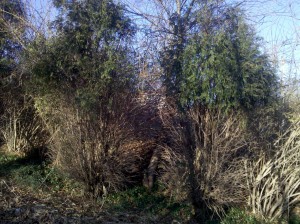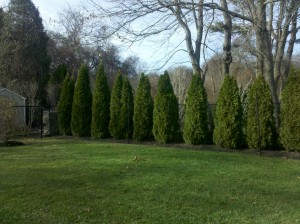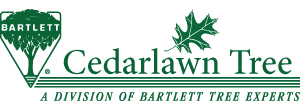Reducing Deer Damage to Plants
Reducing Deer Damage to Plants
As we get into fall and have experienced several hard frosts we begin to notice that we can now see into wooded areas that were green with vegetation a few months ago. This serves to remind us that the wildlife that depend, in part, on vegetation to survive need to expand their foraging territory. Unfortunately for homeowners this means that certain trees and shrubs may become an important part of deer diets during the winter when available vegetation is at a minimum. Favorite plants that deer love to feed on during winter include yews, wintercreeper euonymus, rhododendrons, arborvitae, and hemlocks but will feed on a wide range of plant material if hungry enough.

Figure 1 Deer feeding damage to arborvitaes. Foliage is absent up to the height that deer can reach.
In order to prevent damage to plant material there are several alternatives. Do not rely on folk remedies such as scented soaps, hair, etc. as these are generally not effective. The most commonly used approach involves spraying of a product onto plant material so that deer avoid the plants usually through a combination of taste and odor. Typically this type of product will need to be re-applied during the course of the winter. It is important to first apply this product in the fall before deer establish their browsing habits for the winter. The most common product ingredient is putrescent egg usually with smaller amounts of other ingredients that may include garlic, capsaicin or some type of essential oil. Another product uses Bitrex as its main ingredient. Typically these products perform well if applied early and reapplied according to directions. We apply these products twice during the fall and winter.
Another option is the use of bird netting (used to keep birds from eating fruits and berries). This prevents deer from accessing plant parts beneath the netting. This may be useful if you have only a small number of plants and works best for shrubs such as yews that prevent the material from moving. It is important to prevent deer from being able to get up under the netting.

Figure 2 Flexible deer fencing used in front of the planting is not visible except for support posts
The use of fencing can also be used to prevent access to plants. Fence heights need to be adequate to prevent them from leaping over (usually at least 7.5’ depending on the type of fencing material). Polypropylene plastic is a common type of flexible fencing that is difficult to see and makes it difficult for deer to determine its actualheight (thereby making it less likely they will try to leap it). Adequate posting support is needed and be sure to prevent deer from lifting the fencing with their nose by staking the fencing to the ground. Post sleeves can be permanently installed into the soil at an appropriate spacing to allow easier setup and take down of fencing.




